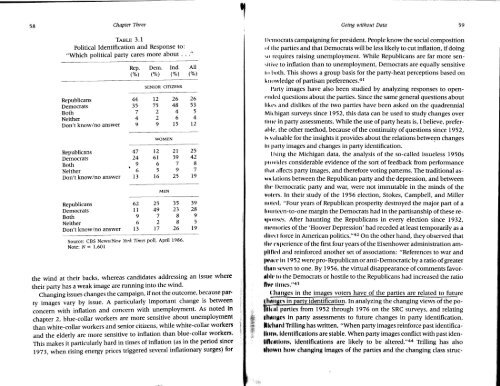Popkin-Reasoning Voter-Ch 3.pdf
Popkin-Reasoning Voter-Ch 3.pdf
Popkin-Reasoning Voter-Ch 3.pdf
Create successful ePaper yourself
Turn your PDF publications into a flip-book with our unique Google optimized e-Paper software.
58<br />
<strong>Ch</strong>apter Three<br />
Tasrn J.l<br />
Political Identification and Response to:<br />
"Which political party cares more about . ."<br />
Republicans<br />
Democrats<br />
Both<br />
Neither<br />
Don't know/no answer<br />
Republicans<br />
Democrats<br />
Both<br />
Neither<br />
Don't know/no answer<br />
Republicans<br />
Democrats<br />
Both<br />
Neither<br />
Don't know/no answer<br />
I<br />
Rep. Dem. Ind. All<br />
(7.\ f/') f/"1 (7"1<br />
SENIOR CITIZENS<br />
44 12 26<br />
35 75 48<br />
724<br />
426<br />
9915<br />
47<br />
24<br />
9<br />
6<br />
l3<br />
WOMEN<br />
t2<br />
6t<br />
6<br />
,<br />
t6<br />
MEN<br />
26<br />
,) 5<br />
4<br />
t2<br />
2t 25<br />
39 42<br />
78<br />
97<br />
25 19<br />
62 25 )5 J9<br />
ll 49 2) 28<br />
9789<br />
628'<br />
13 17 26 19<br />
Source: CBS News/New York Times poll, April 1986'<br />
Note: N : 1,601<br />
the wind at their backs, whereas candidates addressing an issue where<br />
their party has a weak image are running into the wind.<br />
<strong>Ch</strong>anging issues changes the campaign, if not the outcome, because party<br />
images vary by issue. A particularly important change is between<br />
concern with inflation and concem with unemployment' As noted in<br />
chapter 2, blue-collar workers are more sensitive about unemployment<br />
than white-collar workers and senior citizens, while white-collar workers<br />
and the elderly are more sensitive to inflation than blue-collar workers,<br />
This makes it particularly hard in times of inflation (as in the period since<br />
lg7:.,when rising energy prices triggered several inllationary surges) for<br />
1<br />
.,:ji.:<br />
$t,<br />
-}ri<br />
:dF!<br />
:i*it<br />
.{,*!<br />
'i;'<br />
Going without Data<br />
l)t'rnocrats campaigning forpresident. People know the social composition<br />
oI the parties and that Democrats will be less likely to cut inflation, if doing<br />
,,o rcquires raising unemployment. While Republicans are far more sen-<br />
.,itivc to inflation than to unemployment, Democrats are equally sensitive<br />
to lroth. This shows a group basis for the party-heat perceptions based on<br />
h r rowledge of partisan preferences.4r<br />
l'arty images have also been studied by analyzing responses to opent'trrlcd<br />
questions about the parties. Since the same general questions about<br />
likt's and dislikes of the two parties have been asked on the quadrennial<br />
Mlt'lrigan surveys since 1952, this data can be used to study changes over<br />
lltttt' in party assessments. While the use of party heats is, I believe, preferrlrlt',<br />
the other method, because of the continuity of questions since 1952,<br />
lr v,rluable for the insights it provides about the relations between changes<br />
In party images and changes in party identification.<br />
tlsing the Michigan data, the analysis of the so-called issueless 1950s<br />
ptovitlcs considerable evidence of the sort of feedback from performance<br />
llr,rl allt'cts party images, and therefore voting patterns. The traditional aslrr'l,ttions<br />
between the Republican party and the depression, and between<br />
lltr. l)cmocratic party and war, were not immutable in the minds of the<br />
vrrlers. In their study of the 1956 election, Stokes, Campbell, and Miller<br />
nnlcrl, "Four years of Republican prosperity destroyed the major part of a<br />
hnn l('cn-to-one margin the Democrats had in the partisanship of these rerlxnrscs.<br />
After haunting the Republicans in every election since 1932,<br />
Ittcrttrlrics of the 'Hoover Depression'had receded at least temporarily as a<br />
rlltct'f lirrce in American politics."42 O\the other hand, they observed that<br />
lllr, r'xltcrience of the first four years of the Eisenhower administration am-<br />
;tllllerl and reinforced another set of associations: "References to war and<br />
lrdle itt I 952 were pro-Republican or anti-Democratic by a ratio of greater<br />
lhAn scvcn to one. By 1956, the virtual disappearance of comments favoraltlr<br />
to the Democrats or hostile to the Republicans had increased the ratio<br />
fivF lltrrcs."as<br />
(lltatt8c's in the images voters have of the parties are related to future<br />
ghatrgcs in party identification. In analyzing the changing views of the polltlral<br />
parties from 1952 through I976 on the SRC surveys, and relating<br />
€halrges ln party assessments to future changes in party identification,<br />
llehard Trllling has written, "When party images reinforce past identificalktttr,<br />
lde ntifications are stable. When party images conflict with past idenllllcatlons,<br />
ldentlfications are likely to be altered."aa Tfilling has also<br />
thttwtr huw changlng lmages of the parties and the changing class struc-<br />
59


